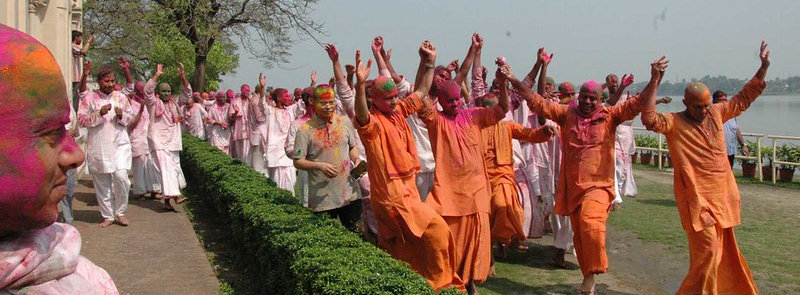
When It Occurs
Annually on Purnima in Hindu Month Phalguna
Timeline
Days Passed (644)
# Hashtags
#Dolyatra #DolPurnima
Dolyatra, also referred to as Dol Jatra or Dol Purnima, is a Hindu festival observed in West Bengal, India. This vibrant celebration of colors commemorates the love shared between Radha and Lord Krishna and is often called the "Swing Festival."
Taking place in March, the specific date fluctuates with the moon's position. In the midst of the festivities, idols portraying Radha and Krishna are adorned and positioned on chariots or palanquins. These idols sway to and fro, accompanied by the melodic tunes sung by women, while men joyfully spray colored powder, adding to the festive atmosphere.
Mythological Significance:
Dolyatra is dedicated to the divine love and devotion of Lord Krishna and his consort, Radha. The festival commemorates the playful and loving relationship between Krishna and Radha and celebrates the arrival of spring, the season of love and fertility.
According to Hindu mythology:
- Krishna, who spent his childhood in Vrindavan, would celebrate the onset of spring with his beloved Radha and the gopis (cowherd maidens) by playfully applying colors on them.
- This playful act of applying color, symbolizing the joy and vibrancy of life, is reflected in the modern-day celebration of Dol Purnima, where devotees engage in color play, music, and dance.
Spiritual Importance:
In addition to being a fun festival, Dolyatra holds a deep spiritual significance. It marks the triumph of devotion and the transcendental love between Krishna and Radha, symbolizing the union of the soul (Radha) with the divine (Krishna). For devotees, Dolyatra is a time to remember and re-enact Krishna’s playful yet spiritual interaction with his devotees.
Rituals and Celebrations:
The celebration of Dolyatra is vibrant and colorful, incorporating various rituals and traditions that emphasize both joy and devotion.
1. Idol Processions:
- Early in the morning on Dol Purnima, idols of Lord Krishna and Radha are adorned with colorful clothes, jewelry, and flowers.
- The idols are then placed on a palanquin (called palki) and taken in a grand procession through the streets. The palanquin is swung gently, symbolizing the playful nature of Krishna.
- Devotees follow the procession, singing devotional songs (bhajans), dancing, and throwing colored powders (abir) into the air.
2. Aarti and Offerings:
- During the festival, a special aarti (ritual worship) is performed for Krishna and Radha. Devotees offer various items such as sweets, fruits, flowers, and gulal (colored powder).
- In many homes and temples, a bhog (feast offering) is prepared for the deities, which is later distributed among the devotees as prasadam (blessed food).
3. Color Play:
- Similar to Holi, people smear each other with colored powders, mainly using abir (a fine, fragrant, and brightly colored powder).
- The act of playing with colors during Dolyatra is symbolic of Krishna’s joyous interaction with his devotees, especially Radha and the gopis. It represents love, joy, and the breaking down of social barriers, as everyone, regardless of caste or class, participates in the fun.
4. Traditional Music and Dance:
- Baul singers, traditional mystic musicians of Bengal, often perform during Dolyatra. They sing devotional songs that express spiritual love and connection with God.
- Kirtans and bhajans dedicated to Krishna are also performed, accompanied by traditional musical instruments like the mridangam and kartal.
5. Smearing of Feet:
- One unique custom of Dolyatra is that younger people apply colored powders to the feet of elders and seek their blessings. This gesture is a mark of respect and signifies familial bonds.
Regional Variations:
-
In West Bengal, the festival is a major event, especially in Shantiniketan, the cultural hub founded by Rabindranath Tagore. Tagore popularized the celebration of Basant Utsav, which coincides with Dolyatra. The festival is celebrated with poetry recitations, traditional dances, music performances, and cultural programs, all in a serene and artistic environment.
-
In Odisha, Dolyatra is also known as Dola Jatra and is celebrated with similar rituals. However, the festival is often observed over five days, with the final day being the most important. Villagers take the idols of Krishna in procession from one house to another, accompanied by music and dance.
-
In Assam, the festival is called Phakuwa and, while similar to Holi, it has its unique regional flavors. People participate in rituals and community gatherings, often incorporating local traditions and folk music.
Connection to Holi:
While Dolyatra is primarily associated with devotion to Krishna and Radha, it also marks the beginning of the Holi festivities in many regions. In some parts of Bengal, the play with colors intensifies the day after Dolyatra, when the festival of Holi, known as Rangwali Holi, is celebrated with even more enthusiasm.
Conclusion:
Dolyatra is a festival that blends joy, devotion, and spirituality. It brings people together in celebration, allowing them to express their love for Krishna through color play, music, and dance. While similar to Holi, Dolyatra has a distinct cultural and religious importance, particularly in eastern India. It symbolizes the joy of spring, the triumph of love and devotion, and the timeless relationship between Krishna and Radha.


